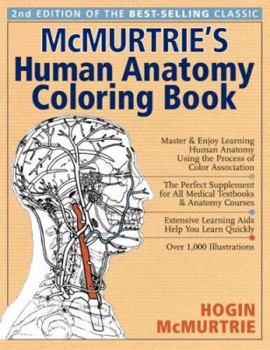McMurtrie's Human Anatomy Coloring Book: A Systemic Approach to the Study of the Human Body: Thirteen Systems
Select Format
Select Condition 
Book Overview
Each year, thousands of students studying to be doctors, physical therapists, and medical technicians have to master the art of anatomy and an equal number of artists want to capture realistic movement and posture. What better way to remember each bone, muscle, and organ than by coloring a picture? The very act of drawing entices the student to spend more time with the image, and to examine the body s structure more closely. That s why this one-of-a-kind coloring book, with its concisely written text and easy-to-color-in medical illustrations, has always been such a huge seller and why it s now revised into this new user-friendly format. Arranged according to body systems, the color-key organization links anatomical terminology to the more than 1,000 precise and detailed black-and-white illustrations.Readers will also appreciate the sleek, lay-flat design, cardboard insert to place under the page for easy drawing, and high-quality paper that makes doing the work simpler and more pleasurable."
Format:Paperback
Language:English
ISBN:1402737882
ISBN13:9781402737886
Release Date:November 2006
Publisher:Sterling Publishing (NY)
Length:320 Pages
Weight:2.64 lbs.
Dimensions:1.0" x 8.4" x 10.8"
Related Subjects
Anatomy Basic Sciences Education & Reference Games Medical Medical Atlases Medical Books Medicine ReferenceCustomer Reviews
3 ratings
Book
Published by Lady of 10 , 2 years ago
Arrived on time
Good book
Simply Amazing Course in Anatomy
Published by Thriftbooks.com User , 17 years ago
Most people will be familiar with the Wynn Kapit and Lawrence M. Elson "Anatomy Coloring Book" which has been around for a while now, and has inspired several spin-offs and knock-offs from various publishers. While that book is very good, this offering from Hogin McMurtrie is my personal favorite i the category. Unlike the Kapit/Elson book, McMurtrie's book is a complete course in anatomy. He begins with basic orientation, general anaomical terminology, and then progresses onto a systematic outline of the various body systems. When I first opened the book, I was initially surprised by how thorough it was. One thing you will notice is, there is a whole lot more TEXT in this book, compared with others of its type. The author takes his time to go through and describe the function and positioning of each example. What's more, there is a thorough treatment of lever systems, the bundling of muscle fibers, and joints unlike anything I have ever seen before in any other book. The one major problem with this book, however, is that, while the diagrams are beautiful in their own right, one gets the sense that this was not intended to be a coloring book at all. The benefit of the Kapit/Elson volume is that it focuses specifically on the color-association. With this book, coloring seems to be somewhat of an afterthough. As a result, the diagrams tend to be a little too detailed for their own good, making coloring a bit of an effort. What's more, the binding is sturdy, but very stiff - the book does not lie flat at all, like the newer edition of the Kapit/Elson. That said, I still highly recommend this book for those who want a more through treatment than the typical coloring book. For beginners, however, the Kapit/Elson edition might be the better choice, at least to begin with.
Good primer for A & P
Published by Thriftbooks.com User , 18 years ago
Not the prototypical anatomies with crayolas... Very thorough and detailed guide, especially well laid out. An excellent primer before a course in A & P at any level. The plates were of such detail that I didn't think to color them, but found myself engrossed in study. Caveat: the plates are not consistently the best for coloring, due to the use of shading for detail and depth. I don't regret that, as I compared it to several others available. I bought this in-store for the practical examples and explanations for joint types, overview of systems, etc. Good 'brass tacks' guide and a nice, clean, detailed one to supplement other texts. BTW, Liked how the text referred to what color types I am to use. Perhaps the authors were being mnemonically pedagogical. Perhaps.





